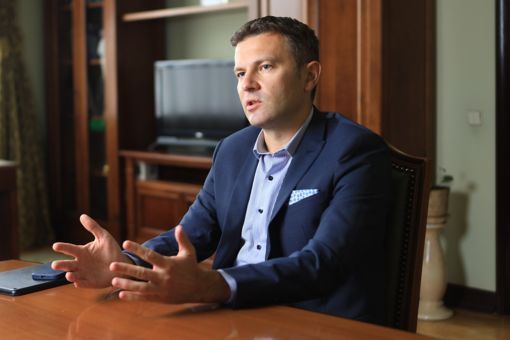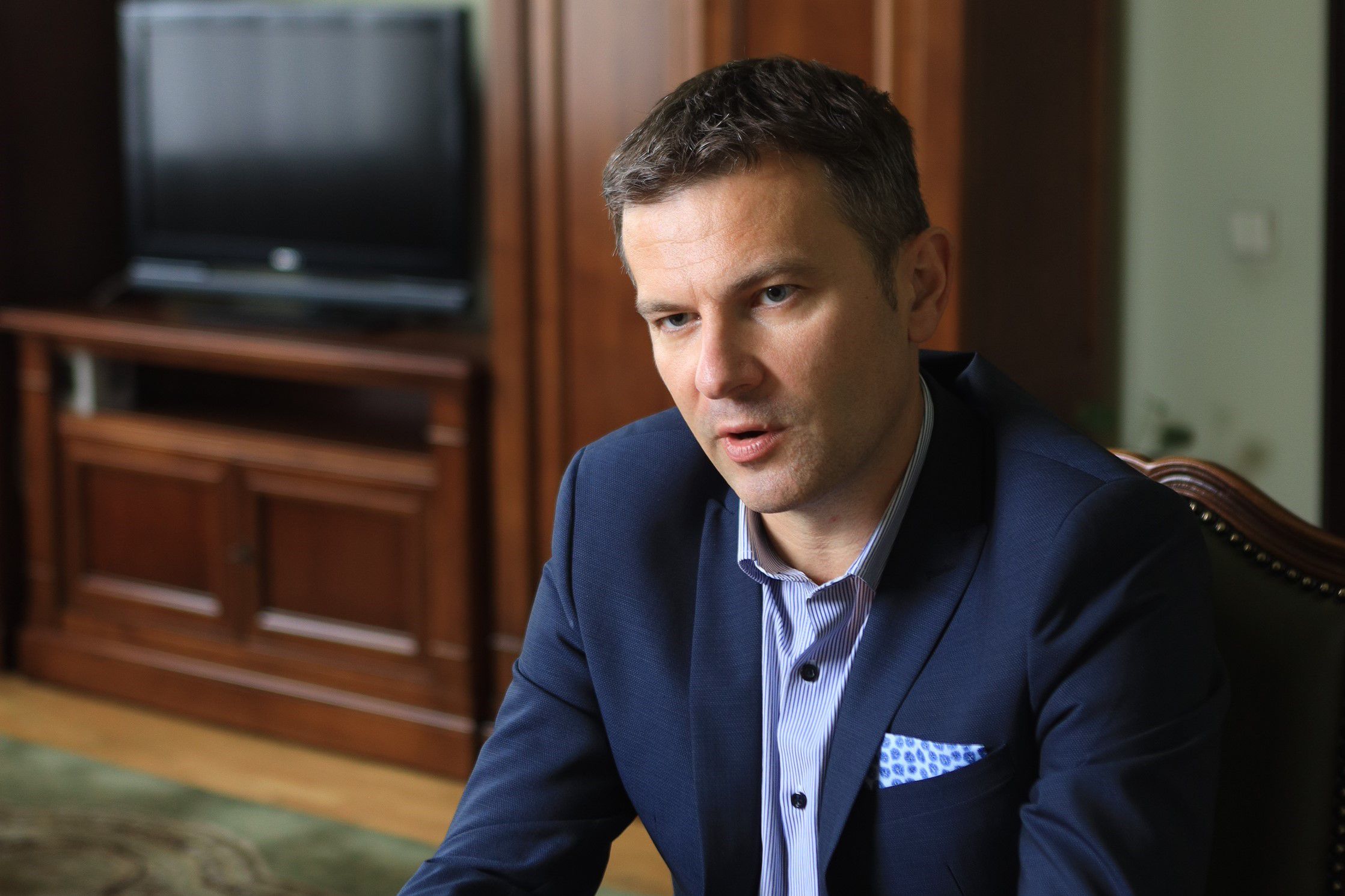In its recent report, the National Bank of Ukraine says that the Ukrainian banking sector survived the first months of the war with only modest losses. This resulted from timely actions taken by the NBU and other Ukrainian banks to ensure the smooth operation of financial institutions. We talked to Sergiy Nikolaychuk, Deputy Governor of the National Bank of Ukraine, in early May about how the banking system reacted to a full-scale Russian invasion of Ukraine, what preparatory work had been done in anticipation of the conflict, and what lessons have been learned that can applied after Ukraine wins.
This discussion was chaired by Dmytro Romanovych, Associate Director, Consulting, Government Projects and International Development Projects, KPMG in Ukraine.

- How did the National Bank of Ukraine prepare for a potential full-scale Russian invasion of Ukraine?
- Which key decisions by the NBU contributed the survival and continuing functioning of the Ukrainian banking system?
- What factors required the banking system to have a high level of resilience during the war?
- How did banks react to NBU decisions? Were you able to interact effectively with them?
- What measures did the NBU take to prepare and ensure proper banking system cybersecurity?
- How do you feel about Ukraine’s “Cloud First Strategy” for banks?
- How different is the situation for the banks compared to 2014–2015? Is it appropriate to compare the two?
- Does it still make sense to predict how the process of privatising state-owned banks will develop as this was actively being prepared for before February?
- The NBU has been a major source of budget funding since the beginning of the war. However, so far, this has not had much of an impact on inflation and macroeconomic stability. How long can such a situation stay relatively stable without huge distortions?
- Tell us about the special fundraising account the NBU has opened to support the Armed Forces.
- What three lessons do you think the financial sector should learn after Ukraine's victory?
For more than two months now the Ukrainian banking system has been absorbing economic and technological shocks. How did the National Bank of Ukraine prepare for a potential full-scale Russian invasion of Ukraine?
The war with Russia has been going on since 2014 so we always anticipated the danger of a full-scale invasion. We prepared in advance and worked jointly with domestic banks to discuss plans for non-stop operation. After the risk of full-scale war increased last autumn, we updated our plans accordingly. We had regular meetings with commercial banks, discussed potential scenarios, and agreed upon potential steps to mitigate issues. However, we never believed that we would have to make those plans a reality.
In the end, sadly, there was a need to put these plans into action and, on 24 February, we started implementing the scenarios we had been working on. That day saw most board members, department directors, and key employees already at work at the bank at 07:00. Owing to the experience we had gained from the events of 2014, we clearly understood what needed to be done in those first days to stop any panic in the foreign exchange market and among depositors, while simultaneously organising the non-stop functioning of the Ukrainian banking system.
Owing to the experience we had gained from the events of 2014, we clearly understood what needed to be done in those first days to stop any panic in the foreign exchange market and among depositors, while simultaneously organising the non-stop functioning of the Ukrainian banking system.
It should also be noted that the banking system in Ukraine is highly digitalised. The COVID-19 crisis, when many bank offices started working remotely, contributed to the proper level of readiness and so banks were easily able to transfer many of their functions online on 24 February.
Which key decisions by the NBU contributed the survival and continuing functioning of the Ukrainian banking system?
Our priority was and still is the smooth operation of Ukraine’s banks – continuity plans were developed by the banks and coordinated with NBU management. We must pay tribute to the heroic efforts of the banks’ employees who kept on working during active military operations, including under shelling and bombing.
It should also be noted that the banking system in Ukraine is highly digitalised. The COVID-19 crisis, when many bank offices started working remotely, contributed to the proper level of readiness and so banks were easily able to transfer many of their functions online on 24 February.
What factors required the banking system to have a high level of resilience during the war?
Here, we would like to name three main factors. The first is the plans we had available for uninterrupted operations and the effectiveness with which they were implemented, which I have already mentioned.
The second factor was reform of the banking system, something that has already been taking place since 2014. Despite the crisis, Ukrainian banks met the war in a good financial shape: prior to renewed hostilities, local banks demonstrated an all-time high in terms of profit margin and had satisfactory liquidity and capital ratios.
The NBU conducted regular stress testing for domestic banks; an important element of preparatory work to ensure their resilience. Banks worked out different scenarios, both base-line and conservative. They reviewed their weak points and learned the necessary lessons in advance.
The third factor was the regulatory efforts undertaken by the National Bank of Ukraine. On the one hand, the NBU imposed limitations on the national banking system to lessen the probability and that scale of funds and capital outflow from the country, though no market mechanisms could entirely prevent this. On the other hand, the NBU provided total support to banks to help them survive this initial phase.

How did banks react to NBU decisions? Were you able to interact effectively with them?
The restrictions imposed by the NBU let banks curb depositor panic and contributed to their smooth operation. Two hours after the NBU adopted its Resolution on Restrictions (ed. Resolution no. 18 dated 24 February 2022 ), we held a meeting with the heads of the largest banks. This is where we first agreed upon our further operations during actual hostilities rather than as a simulated scenario. We communicate with banks on a regular basis and held meetings every week during the first month where we discussed the most painful issues. We now hold similar meetings every two weeks. Said meetings are still useful and, while the urgency of those specific problems is gradually fading away, there are still unresolved issues that we discuss regularly.
15 February saw the largest Distributed Denial of Service (DDoS) attack on the banking system in Ukraine's history, nine days before the Russian full-scale invasion of Ukraine. Experts say that this attack ended up being more psychological than destructive in nature as it failed to destroy our infrastructure. What measures did the NBU take to prepare and ensure proper banking system cybersecurity?
On 15 February, hackers carried out a powerful DDoS attack against the web portals of several Ukrainian governmental institutions, including the official websites of the Ministry of Defense and the Armed Forces, and the online services of two major state banks: Privatbank and Oschadbank. However, services were almost 100% restored by 19:00 of the same day. These DDoS attacks continued the next morning but by noon both Privatbank and Oschadbank had fully resumed their operations. There were also several waves of attacks against the online services of other banks but none of them lost operability. In less than a day, all Ukrainian banks’ systems had recovered and were running normally, even in the face of continuing DDoS attacks.
Hackers also attacked the National Bank of Ukraine but their attack was neutralised with no extra effort. I would not say that we feel safer now, since attempts to destroy NBU systems and the systems of other banks are still ongoing. However, those attacks have been and continue to be successfully repulsed. All the National Bank’s information systems keep on operating normally, including our official website, our internal network, and the electronic payment system used by other banks.
Since 2014, our crisis plan has included scenarios for mitigating risk and protecting the banking system from DDoS attacks, as well as using the most advanced technologies and cybersecurity solutions to ensure the resilience of the Ukrainian banking system against other cyber risks. The NBU also has a mechanism for exchanging information about cyberattacks between the cyber defence centre of the National Bank and other agencies, banks, financial institutions, etc.
Since 2014, our crisis plan has included scenarios for mitigating risk and protecting the banking system from DDoS attacks, as well as using the most advanced technologies and cybersecurity solutions to ensure the resilience of the Ukrainian banking system against other cyber risks.
On 21 February, Ukrainian Parliament passed the Cloud Services Act which means that public authorities can now use cloud technologies to store data in the cloud. How do you feel about Ukraine’s “Cloud First Strategy” for banks?
This was signed into law by the President in March of this year. It lays the foundation for developing information and communication technology platforms based on cloud computing, and implementing cloud environment policies in relation to public administration, education, science, and other spheres of public life as a matter of priority. The Act actually follows the general approach taken by many leading countries and banking institutions since 2011, including the United States, the UK, and the European Union.
The Act should become fully operational this autumn, but the National Bank legally regulated the use of cloud services by banks and processing centres in the first days of the war.
We were already well aware that servers had a high potential for physical seizure or destruction during the war which could have complicated the smooth operation of the Ukrainian banking system. Now that banks have the right to use cloud technology, they can resume operations and retain all necessary information in the event of a server crash.
How different is the situation for the banks compared to 2014–2015? Is it appropriate to compare the two?
It makes no sense comparing these two situations. In 2014, the Ukrainian banking system was weak and this eventually resulted in a lot of bankruptcy cases. Conversely, the banking system today is strong and well-prepared. Obviously, the situation for Ukrainian banks has deteriorated somewhat since 24 February but we cannot quantify that right now as the situation varies from bank to bank.
The National Bank of Ukraine has initiated amendments to laws that make it impossible to apply measures to punish banks for non-compliance with standards like capital adequacy and liquidity. In this way, we have made it possible for Ukrainian banks to continue their operations even if their standards are lower than regulatory values. It is therefore possible for the banks to keep on lending, even if they suffer losses.
As for liquidity, during the first weeks of the war we had some pressure on the liquidity of banks, primarily because Ukrainians were actively withdrawing cash. However, this trend ended as a result of robust and relatively uninterrupted online banking services. Now, we see individuals’ deposits in hryvnia have increased by about 20% since the start of the war, while corporate deposits began to grow as soon as economic activity started increasing in mid-April.
We are not concerned about the level of liquidity in the banking system, this has actually increased since the beginning of the war. For example, in recent weeks the amount of deposit certificates in commercial bank portfolios has been steady, amounting to around UAH180 billion.

Does it still make sense to predict how the process of privatising state-owned banks will develop as this was actively being prepared for before February?
Despite the war, we have not postponed our plans to continue reforming the Ukrainian banking system. One of these plans has already been implemented: Oschadbank has become a member of the Deposit Guarantee Fund. As before, we believe that the share of the public sector in the banking system should fall to 25%.
We understand that during wartime, state-owned banks have much more credit. They are more active in the lending market, participating in small- and medium-sized business lending programs supported by the Ukrainian government; like lending to agrobusinesses. However, I would stress once again that our strategic goal to reduce the share of the public sector to 25% still remains relevant.
Despite the war, we have not postponed our plans to continue reforming the Ukrainian banking system.
As before, we believe that the share of the public sector in the banking system should fall to 25%.
The NBU has been a major source of budget funding since the beginning of the war. However, so far, this has not had much of an impact on inflation and macroeconomic stability. How long can such a situation stay relatively stable without huge distortions?
After the first days of the war, we understood that it was no longer feasible to implement a monetary policy based on market mechanisms and inflation targeting where the key tool is the discount rate. During the war, many parts of monetary transmission systems simply do not work. We had one tool left to satisfy the expectations of the Ukrainian population and business: namely, to fix the exchange rate.
It was a forced decision that could have resulted in depleting our reserves during the war. That said, by using currency restrictions, we managed to reduce the demand for currency and prevent capital flight.
Given that we decided on the expediency of financing the budget deficit via the National Bank (since the beginning of the war, the NBU has purchased UAH100 billion, or more than USD3 billion, of domestic government bonds), the economy will need to gain some fiscal momentum. The large budget deficit is mainly due to falling budget revenues and the need for huge military, humanitarian, and social spending.
That approach can work as long as we have international reserves. At the beginning of May, the level of reserves reached about USD27 billion, which is close to what was available at the beginning of the war. We spend USD2 billion per month to meet our defense needs, critical imports, and payments. All the while, we continue to receive funding from foreign partners: about USD5 billion has been received since the war began.
But we understand that this system is not viable in the long run. We will not be able to permanently survive solely through external borrowing or grants. We will need to gradually restore the normal functioning of the foreign exchange market, which needs to be more balanced, and return to inflation targeting, using the discount rate as our main tool.
Since the start of the war, we have accumulated over UAH16.5 billion which we transferred to meet the relevant requests of the National Guard, the National Police, the Ministry of Defense of Ukraine, and the State Border Guard Service.
Please tell us more about the special fundraising account the NBU has opened to support the Armed Forces. This was a very unexpected step, was it effective?
On the first day of the war, the members of the National Bank Board had the idea to open an ear-marked account so that everyone who wanted could transfer funds to support the Armed Forces of Ukraine. We understood that there would be many people who wish to do so, and the NBU has the advantage of a level of associated trust that many fundraising organisations lack.
Since the start of the war, we have accumulated over UAH16.5 billion which we transferred to meet the relevant requests of the National Guard, the National Police, the Ministry of Defense of Ukraine, and the State Border Guard Service. The lion's share of these funds came from common citizens of Ukraine. About UAH5 billion in equivalent came in foreign currencies from abroad.
What three lessons do you think the financial sector should learn after Ukraine's victory?
The first lesson is that banking reforms are working. If you do things that are in line with global practices and expert recommendations, you can make the system much stronger. The reforms that have taken place in the banking system confirm this. After the war, we will continue to implement them.
The second lesson is risk management. You need to be well-prepared for the harshest scenarios. Stress testing banks, which we did every year before the war, proved to be a useful exercise that allowed banks to prepare for renewed conflict.
The third lesson is that the role of digital technologies in our lives is on the rise, and the latest trend towards digitalisation of the banking system over the latest 10–20 years will only intensify. In this context, the matter of cybersecurity is becoming increasingly important.


